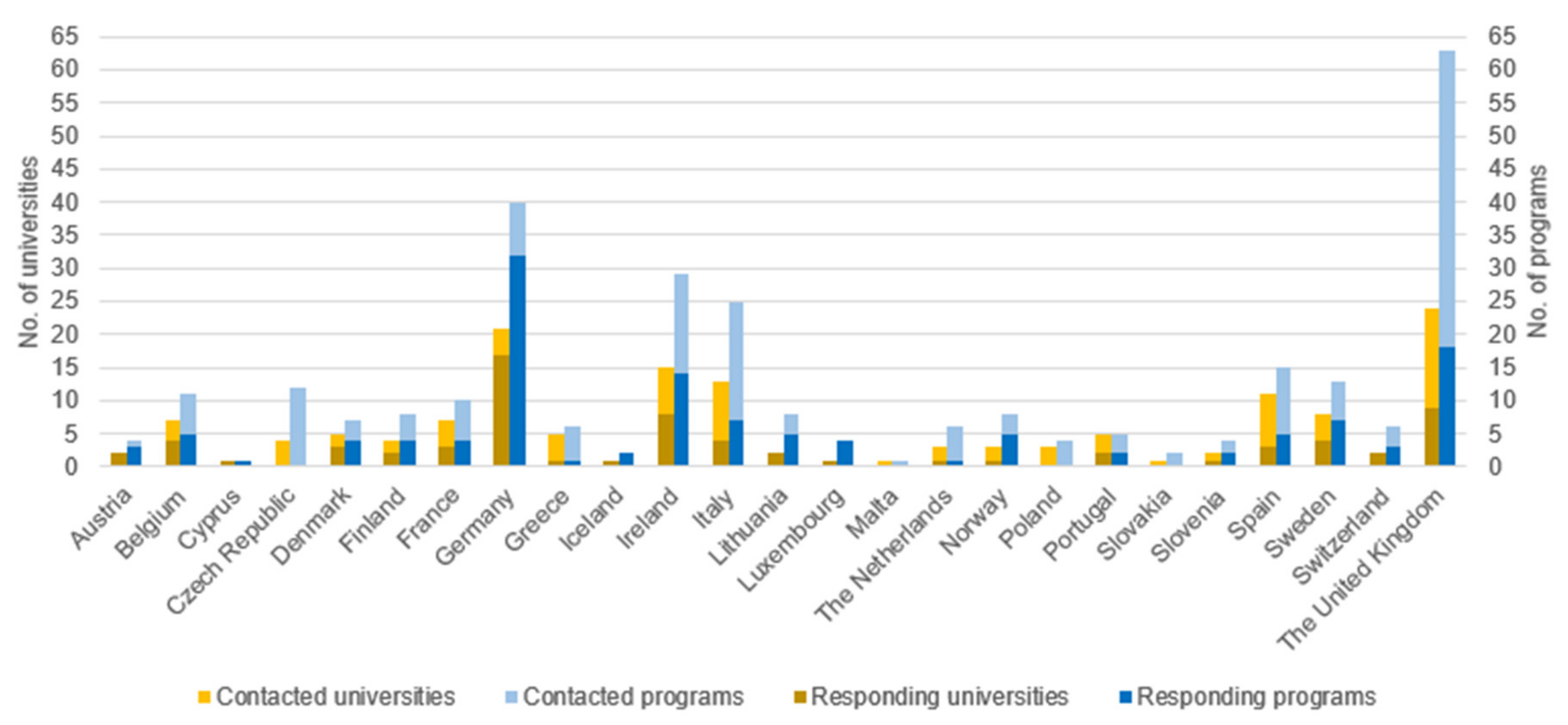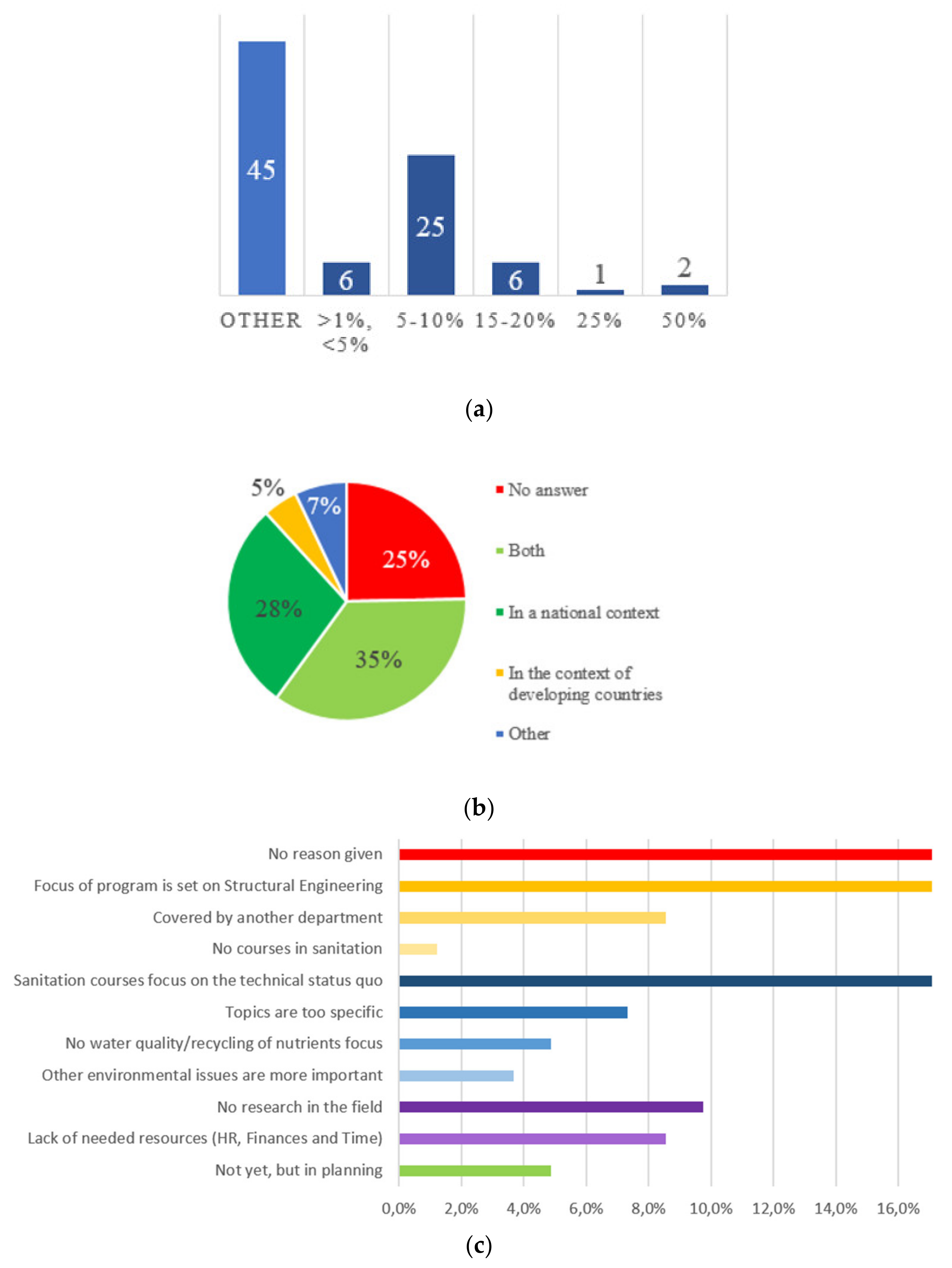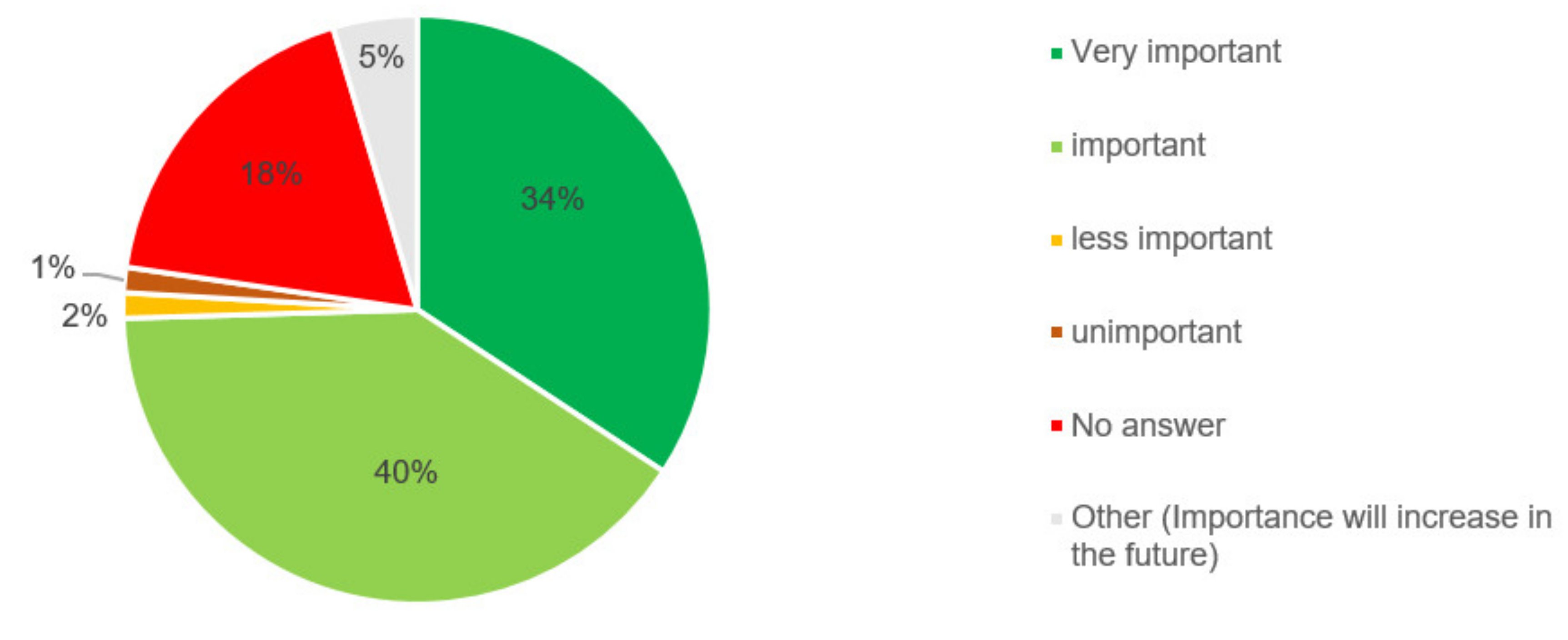Ecological Sanitation and Sustainable Nutrient Recovery Education: Considering the Three Fixes for Environmental Problem-Solving
Abstract
1. Introduction
1.1. Sustainable and Ecological Sanitation
1.2. Considering the Human Element
The Three Fixes for Environmental Problem-Solving
2. Methodology
2.1. Survey Methods
2.1.1. Survey Participants
2.1.2. Survey Questionnaire
2.1.3. Survey Analysis
3. Results
3.1. General Evaluations
3.1.1. Covering Ecological Sanitation and the Recycling of Nutrients in Education
3.1.2. The Extent of Coverage
3.1.3. The Context of Coverage
3.1.4. Reasons for Not Teaching about Nutrient Recycling
3.1.5. The Importance of Nutrient Recycling and Ecological Sanitation
3.1.6. The Percentage Origin of Students
4. Discussion
4.1. Considering a Combination of the Three Fixes to Environmental Behavior
4.2. Understanding Attitudes and Emotions (Disgust)
- “The term ecological sanitation can mean many things to many different people. I have often associated it with not very good onsite sanitation systems, which require quite a bit of handling of fecal material, behavioral change, and risk of helminth transmission. If you think this an unduly negative view I strongly urge you to get some first-hand experience with someone else’s fresh human excreta! However, the reuse of nutrients in wastewater and fecal wastes is, in principle, a good thing… the range of workable technologies is limited. And this affects what we can teach.” (English faculty)
- “I think it is a very important topic which is why I give lectures on it to both undergraduate and post graduate students. I want the students to leave the College realizing that there is a big opportunity to recover valuable resources from wastewater.” (Irish faculty)
- “YES, because it is an important topic (I did my PhD and Habilitation about that topic!)” (German faculty)
4.3. Limitations
5. Conclusions
- There is an apparent need to address the sustainability of the sanitation systems in Europe and around the world. In this context, the recycling and reusing of human wastewater under Target 6.3 of the SDGs must be promoted. While there is elaborate research about technological and ecological solutions, social factors have been investigated less vigorously. This article tried to evaluate the state of sanitation education in Europe when it comes to recycling practices. The research results show that knowledge about EcoSan and the recycling of nutrients within the higher education programs of civil engineering and related fields is not lacking, and that these topics are perceived as important.
- There are differences of considered technology when it comes to the geographical context of the education.
- The main impediment in education programs can be traced back to structural conditions and the technical status quo.
- In order to successfully implement the recycling of human wastewater, one needs to consider a feedback-driven combination of the three fixes to environmental problem-solving.
- Positive and negative attitudes may play an important role in terms of individual commitment and the emotion of disgust and require further research.
6. Outlook
…universities as a whole and university staff in particular, should try to take more advantage of the many opportunities SDGs provide to them, not only in respect to teaching and research but especially in respect of their outreach activities… [35] (p. 294)
Author Contributions
Funding
Acknowledgments
Conflicts of Interest
References
- United Nations. Transforming Our World: The 2030 Agenda for Sustainable Development; United Nations: New York, NY, USA, 2015. [Google Scholar]
- The Sustainable Development Agenda. Available online: https://www.un.org/sustainabledevelopment/development-agenda/ (accessed on 10 November 2019).
- Andersson, K.; Dickin, S.; Rosemarin, A. Towards “sustainable” sanitation: Challenges and opportunities in urban areas. Sustainability 2016, 8, 1289. [Google Scholar] [CrossRef]
- Sustainable Sanitation Alliance (SuSanA). Sustainable Sanitation–The Definition. Available online: https://www.susana.org/en/about/vision-mission/sustainable-sanitation (accessed on 20 February 2020).
- Daigger, G.T. Evolving urban water and residuals management paradigms: Water reclamation and reuse, decentralization, and resource recovery. Water Environ. Res. 2009, 81, 809–823. [Google Scholar] [CrossRef]
- Werner, C.; Panesar, A.; Rüd, S.B.; Olt, C.U. Ecological sanitation: Principles, technology and project examples for sustainable wastewater and excreta management. Desalination 2009, 248, 392–401. [Google Scholar] [CrossRef]
- Rosenquist, L.E.D. A psychological analysis of the human-sanitation nexus. J. Environ. Psychol. 2005, 25, 335–346. [Google Scholar] [CrossRef]
- Gujer, W. Siedlungswasserwirtschaft, 3rd ed.; Springer: Berlin/Heidelberg, Germany, 2007; pp. 2–15, 385–390. [Google Scholar]
- Villarín, M.C.; Merel, S. Paradigm shifts and current challenges in wastewater management. J. Hazard. Mater. 2020, 390, 122139. [Google Scholar] [CrossRef] [PubMed]
- Trimmer, J.T.; Guest, J.S. Recirculation of human-derived nutrients from cities to agriculture across six continents. Nat. Sustain. 2018, 1, 427–435. [Google Scholar] [CrossRef]
- Krüger, O.; Adam, C. Phosphorus in recycling fertilizers – analytical challenges. Environ. Res. 2017, 155, 353–358. [Google Scholar] [CrossRef] [PubMed]
- Cordell, D.; Drangert, J.-O.; White, S. The story of phosphorus: Global food security and food for thought. Glob. Environ. Chang. 2009, 19, 292–305. [Google Scholar] [CrossRef]
- Ashley, K.; Cordell, D.; Mavinic, D. A brief history of phosphorus: From the philosopher’s stone to nutrient recovery and reuse. Chemosphere 2011, 84, 737–746. [Google Scholar] [CrossRef] [PubMed]
- Drangert, J.-O. Phosphorus–A limited resource that could be made limitless. Procedia Eng. 2012, 46, 228–233. [Google Scholar] [CrossRef][Green Version]
- Rosemarin, A. Peak phosphorus and the eutrophication of surface waters: A symptom of disconnected agricultural and sanitation policies. In on the Water Front; SIWI: Stockholm, Swedish, 2011; pp. 73–82. [Google Scholar]
- Rosemarin, A.; de Bruijne, G.; Caldwell, I. Peak phosphorus: The next inconvenient truth. Broker 2009, 15, 6–9. [Google Scholar]
- Xu, K.; Li, J.; Zheng, C.; Xie, T.; Wang, C. The precipitation of magnesium potassium phosphate hexyhydrate for P and K recovery from synthetic urine. Water Res. 2015, 80, 71–79. [Google Scholar] [CrossRef] [PubMed]
- Cordell, D.; Rosemarin, A.; Schröder, J.J.; Smit, A.L. Towards global phosphorus security: A systems framework for phosphorus recovery and reuse options. Chemosphere 2011, 84, 747–758. [Google Scholar] [CrossRef] [PubMed]
- Pearce, B.B.J. Phosphorus Recovery Transition Tool (PRTT): A transdisciplinary framework for implementing a regenerative urban phosphorus cycle. J. Clean. Prod. 2015, 109, 203–215. [Google Scholar] [CrossRef]
- Kirchherr, J.; van Santen, R. Research on the circular economy: A critique of the field. Resour. Conserv. Recycl. 2019, 151, 104480. [Google Scholar] [CrossRef]
- Schröder, P.; Lemille, A.; Desmond, P. Making the circular economy work for human development. Resour. Conserv. Recycl. 2020, 156, 104686. [Google Scholar] [CrossRef]
- Schröder, P.; Anggraeni, K.; Weber, U. The relevance of circular economy practices to the sustainable development goals. J. Ind. Ecol. 2018, 23, 77–95. [Google Scholar] [CrossRef]
- Suárez-Eiroa, B.; Fernández, E.; Méndez-Martínez, G. Operational principles of circular economy for sustainable development: Linking theory and practice. J. Clean. Prod. 2019, 214, 952–961. [Google Scholar] [CrossRef]
- Makropoulos, C.; Rozos, E.; Tsoukalas, I.; Plevri, A.; Karakatsanis, G.; Karagiannidis, L.; Makri, E.; Lioumis, C.; Noutsopoulos, C.; Mamais, D.; et al. Sewer-mining: A water reuse option supporting circular economy, public service provision and entrepreneurship. J. Environ. Manag. 2017, 1–14. [Google Scholar] [CrossRef]
- Wielemaker, R.C.; Weijma, J.; Zeeman, G. Harvest to harvest: Recovering nutrients with New Sanitation systems for reuse in Urban Agriculture. Resour. Conserv. Recycl. 2018, 128, 426–437. [Google Scholar] [CrossRef]
- McConville, J.R.; Kvarnström, E.; Jönsson, H.; Kärrman, E.; Johannsson, M. Source separation: Challenges & opportunities for transition in the Swedish wastewater sector. Resour. Conserv. Recycl. 2017, 120, 144–156. [Google Scholar] [CrossRef]
- Skambraks, A.-K.; Kjerstadius, H.; Meier, M.; Davidsson, Å.; Wuttke, M.; Giese, T. Source separation sewage systems as a trend in urban wastewater management: Drivers for the implementation of pilot areas in Northern Europe. Sustain. Cities Soc. 2017, 28, 287–296. [Google Scholar] [CrossRef]
- Winblad, U.; Simpson-Hébert, M. Ecological Sanitation–Revised and Enlarged Edition, 2nd ed.; SEI: Stockholm, Sweden, 2004. [Google Scholar]
- Simha, P.; Ganesapillai, M. Ecological sanitation and nutrient recovery from human urine: How far have we come? A review. Sustain. Environ. Res. 2017, 27, 107–116. [Google Scholar] [CrossRef]
- Mihelcic, J.R.; Fry, L.M.; Shaw, R. Global potential of phosphorus from human urine and feces. Chemosphere 2011, 84, 832–839. [Google Scholar] [CrossRef] [PubMed]
- Jonsson, A.; Land, A. An Evaluation of the Long-Term Functionality of Ecological Sanitation (Ecosan) Projects in Rural Burkina Faso–Reuse of Sanitized Human Excreta as Fertilizer in Local Agriculture; KTH Royal Institute of Technology: Stockholm, Swedish, 2017. [Google Scholar]
- Heberlein, T.A. Navigating Environmental Attitudes; Oxford Unversity Press: New York, NY, USA, 2012. [Google Scholar]
- Zhou, X.; Li, Z.; Zheng, T.; Yan, Y.; Li, P.; Odey, E.A.; Mang, H.P.; Uddin, S.M.N. Review of global sanitation development. Environ. Int. 2018, 120, 246–261. [Google Scholar] [CrossRef] [PubMed]
- Pooley, J.A.; O’Connor, M. Environmental education and attitudes: emotions and beliefs are what is needed. Environ. Behav. 2000, 32, 711–723. [Google Scholar] [CrossRef]
- Filho, W.L.; Shiel, C.; Paço, A.; Mifsud, M.; Ávila, L.V.; Brandli, L.L.; Molthan-Hill, P.; Pace, P.; Azeiteiro, U.M.; Vargas, V.R.; et al. Sustainable development goals and sustainability teaching at universities: Falling behind or getting ahead of the pack? J. Clean. Prod. 2019, 232, 285–294. [Google Scholar] [CrossRef]
- Beynaghi, A.; Trencher, G.; Moztarzadeh, F.; Mozafari, M.; Maknoon, R.; Filho, W.L. Future sustainability scenarios for universities: Moving beyond the United Nations Decade of Education for Sustainable Development. J. Clean. Prod. 2016, 112, 3464–3478. [Google Scholar] [CrossRef]
- Ishii, S.K.I.; Boyer, T.B. Student support and perceptions of urine source separation in a university community. Water Res. 2016, 100, 146–156. [Google Scholar] [CrossRef]
- Jenssen, P.D.; Heeb, J.; Huba-Mang, E.; Gnanakan, K.; Warner, W.S.; Refsgaard, K.; Stenström, T.-A.; Guterstam, B.; Alsén, K.W. Ecological Sanitation and Reuse of Wastewater–A Thinkpiece on Ecological Sanitation; The Agricultural University of Norway (NLH): Ås, Norway, 2004; pp. 1–18. [Google Scholar]
- Vocabulary: Status Quo. Available online: https://www.vocabulary.com/dictionary/status%20quo (accessed on 20 February 2020).
- Guest, J.S.; Skerlos, S.J.; Barnard, J.L.; Beck, M.B.; Daigger, G.T.; Hilger, H.; Jackson, S.J.; Karvazy, K.; Kelly, L.; Macpherson, L.; et al. A new planning and design paradigm to achieve sustainable resource recovery from wastewater. Environ. Sci. Technol. 2009, 43, 6126–6130. [Google Scholar] [CrossRef]
- Ricart, S.; Rico, A.M.; Ribas, A. Risk-yuck factor nexus in reclaimed wastewater for irrigation: Comparing farmers’ attitudes and public perception. Water 2019, 11, 187. [Google Scholar] [CrossRef]
- Schultz, P.W.; Kaiser, F.G. Promoting pro-environmental behavior. In Oxford Handbooks Online; Oxford University Press (China): Hong Kong, China, 2012; pp. 1–30. [Google Scholar]
- Corral-Verdugo, V.; Frías-Armenta, M.; Tapia-Fonllem, C.O.; Fraijo-Sing, B. Protecting natural resources: psychological and contextual determinants of freshwater conservation. In Oxford Handbooks Online; Oxford University Press (China): Hong Kong, China, 2012; pp. 1–19. [Google Scholar] [CrossRef]
- Wei, J.; Wei, Y.; Western, A. Evolution of the societal value of water resources for economic development versus environmental sustainability in Australia from 1843 to 2011. J. Glob. Environ. Chang. 2017, 42, 82–92. [Google Scholar] [CrossRef]
- Curtis, V.; de Barra, M.; Aunger, R. Disgust as an adaptive system for disease avoidance behaviour. Philos. Trans. R. Soc. B 2011, 366, 389–401. [Google Scholar] [CrossRef] [PubMed]
- Curtis, V.A. Dirt, disgust and disease: A natural history of hygiene. J. Epidemiol. Community Health 2007, 61, 660–664. [Google Scholar] [CrossRef]
- Curtis, V. Why disgust matters. Philos. Trans. R. Soc. B 2011, 366, 3478–3490. [Google Scholar] [CrossRef]
- Lofrano, G.; Brown, J. Wastewater management through the ages: A history of mankind. Sci. Total Environ. 2010, 408, 5254–5264. [Google Scholar] [CrossRef]
- Lyu, S.; Chen, W.; Zhang, W.; Fan, Y.; Jiao, W. Wastewater reclamation and reuse in China: Opportunities and challenges. J. Environ. Sci. 2016, 39, 86–96. [Google Scholar] [CrossRef]
- Vought, L. (Environmental Awareness International, Hörby, Skåne, Sweden). Personal communication, 2020. [Google Scholar]
- Kollmuss, A.; Agyemann, J. Mind the gap: Why do people act environmentally and what are the barriers to pro-environmental behavior? Environ. Educ. Res. 2002, 8, 239–260. [Google Scholar] [CrossRef]
- Krasney, M.E. Advancing Environmental Education Practice; Cornell University Press: Ithaca, NY, USA, 2020. [Google Scholar]
- Chu, S.; Majumdar, A. Opportunities and challenges for a sustainable energy future. Nature 2012, 488, 294–303. [Google Scholar] [CrossRef]
- Beery, T.; Kyttä, M.; Olafsson, A.S.; Plieninger, T.; Raymond, C.; Sandberg, M.; Stenseke, M.; Tengö, M.; Jönsson, K.I. Fostering incidental experiences of nature through green infrastructure planning. Ambio 2017, 46, 717–730. [Google Scholar] [CrossRef]
- Thaler, R.H.; Sunstein, C.R. Nudge: Improving Decisions About Health, Wealth and Happiness; Yale University Press: New Haven, CT, USA, 2008. [Google Scholar]
- Brick, K.; DeMartino, S.; Visser, M.; Behavioural nudges for water conservation in unequal settings. Experimental evidence from Capetown. EfD Discuss. Pap. Ser. DP 19-19. 2019, pp. 1–55. Available online: https://efdinitiative.org/publications/behavioural-nudges-water-conservation-unequal-settings (accessed on 22 April 2020).
- Bundesgütegemeinschaft Kompost e.V. (BGK) Novelle Klärschlammverordnung im Bundesrat beschlossen. 2017. Available online: https://www.kompost.de/fileadmin/user_upload/Dateien/HUK-Dateien/2017/05_2017/Novelle_Klaerschlammverordnung_im_Bundesrat_beschlossen__HUK_nachrichten_5_2017.pdf (accessed on 20 February 2020).
- Laux, D. Novellierung der Klärschlammverordnung, Ministerium für Umwelt; Klima und Energiewirtschaft des Landes Baden-Württemberg: Stuttgart, Germany, 2017; pp. 1–22. Available online: https://docplayer.org/63574819-Novellierung-der-klaerschlammverordnung-dr-ing-daniel-laux-referat-25-kommunale-kreislaufwirtschaft-abfalltechnik.html (accessed on 20 February 2020).
- Eidgenössisches Department für Umwelt, Verkehr, Energie und Kommunikation (UVEK): Grüne Wirtschaft. Available online: https://www.uvek.admin.ch/uvek/de/home/umwelt/gruene-wirtschaft.html (accessed on 20 February 2020).
- Ernst Basler; Partner AG (EBP). Beurteilung von Technologien zur Phosphor-Rückgewinnung: Gesamtheitliche Beurteilung der Nachhaltigkeit und Realisierbarkeit von P-Rückgewinnungstechnologien im Schweizer Kontext Zollikon, Schweiz. 2017. Available online: https://www.deutsche-phosphor-plattform.de/wp-content/uploads/2017/03/P-Studie-Schweiz-2017.pdf (accessed on 20 February 2020).
- Amt für Abfall, Wasser, Energie und Luft (AWEL). Phosphor-Mining: Die Zielvorgaben lassen sich erfüllen. Projektblatt Nr. 5 2017, 5, 1–4. Available online: https://phosphorusplatform.eu/images/download/AWEL_Phosphor_Nr_5_German.pdf (accessed on 20 February 2020).
- Ajzen, I. The theory of planned behavior. Organ. Behav. Hum. Decis. Process. 1991, 50, 179–211. [Google Scholar] [CrossRef]
- Ernst, J.; Blood, N.; Beery, T. Environmental action and student environmental leaders: Exploring the influence of environmental attitudes, locus of control, and sense of personal responsibility. Environ. Educ. Res. 2017, 3, 145–175. [Google Scholar] [CrossRef]
- Marcinkowski, T.; Reid, A. Reviews of research on the attitude–behavior relationship and their implications for future environmental education research. Environ. Educ. Res. 2019, 25, 459–471. [Google Scholar] [CrossRef]
- Schwartz, S.H. Normative influences on altruism. In Advances in Experimental Social Psychology; Berkowitz, L., Ed.; Academic Press: New York, NY, USA, 1977; Volume 10, pp. 221–279. [Google Scholar]
- Schwartz, S.H. Awareness of consequences and the influence of moral norms on interpersonal behavior. Sociometry 1968, 31, 355–369. [Google Scholar] [CrossRef]
- Bamberg, S.; Möser, G. Twenty years after Hines, Hungerford, and Tomera: A new meta-analysis of psycho-social determinants of pro-environmental behavior. J. Environ. Psychol. 2007, 27, 14–25. [Google Scholar] [CrossRef]
- Corcelli, L. Flush It and Forget It: A Recipe for Disaster. The EPA Blog 2015. Available online: https://blog.epa.gov/2015/04/16/flush-it-and-forget-it-a-recipe-for-disaster/ (accessed on 19 February 2020).
- Von Borgstede, C.; Lundquist, L.J. Whose responsibility? Swedish local decision makers and the scale of climate change abatement. Urban Aff. Rev. 2008, 43, 299–324. [Google Scholar] [CrossRef]
- Takala, A. Understanding sustainable development in Finnish water supply and sanitation services. Int. J. Sustain. Built Environ. 2017, 6, 501–512. [Google Scholar] [CrossRef]
- European Commission (EC). Special Eurobarometer 419: Public Perceptions of Science, Research and Innovation; Report 2014; European Union (EU): Brussels, Belgium, 2014. [Google Scholar]
- European Commission (EC). Special Eurobarometer 416: Attitudes of European Citizens Towards the Environment; Report 2014; European Union (EU): Brussels, Belgium, 2014. [Google Scholar]
- Cheng, S.; Li, Z.; Uddin, S.M.N.; Mang, H.-P.; Zhou, X.; Zhang, J.; Zheng, L.; Zhang, L. Toilet revolution in China. J. Environ. Manag. 2018, 216, 347–356. [Google Scholar] [CrossRef]
- Seifert, C.; Krannich, T.; Guenther, E. Gearing up sustainable thinking and reducing the bystander effect—A case study of wastewater treatment plants. J. Environ. Manag. 2019, 231, 155–165. [Google Scholar] [CrossRef]
- Stal, E.; Andreassi, T.; Fujino, A. The role of university incubators in stimulating academic entrepreneurship. RAI Revista de Administração e Inovação 2016, 13, 89–98. [Google Scholar] [CrossRef]
- Simha, P.; Lalander, C.; Vinnerås, B.; Ganesapillai, M. Farmer attitudes and perceptions to the re-use of fertiliser products from resource-oriented sanitation systems–The case of Vellore, South India. Sci. Total Environ. 2017, 581–582, 885–896. [Google Scholar] [CrossRef] [PubMed]



| Survey Questions |
|---|
| 1. Is ecological sanitation and recycling of phosphorus, nitrogen and potassium in form of struvite (ex.) part of your programme? |
| a. IF SO, which percentage does this practice have in your lectures and courses approximately? |
| b. IF SO, is this practice considered as a chance for _______ (the country the particular university is located in) or only discussed as a potential system in developing countries? |
| c. IF NOT, why not? |
| 2. How important (very important, important, less important, unimportant) is this topic in your opinion? |
| 3. In which percentage do national, European and international students participate in your programme? |
© 2020 by the authors. Licensee MDPI, Basel, Switzerland. This article is an open access article distributed under the terms and conditions of the Creative Commons Attribution (CC BY) license (http://creativecommons.org/licenses/by/4.0/).
Share and Cite
Junghanns, J.; Beery, T. Ecological Sanitation and Sustainable Nutrient Recovery Education: Considering the Three Fixes for Environmental Problem-Solving. Sustainability 2020, 12, 3587. https://doi.org/10.3390/su12093587
Junghanns J, Beery T. Ecological Sanitation and Sustainable Nutrient Recovery Education: Considering the Three Fixes for Environmental Problem-Solving. Sustainability. 2020; 12(9):3587. https://doi.org/10.3390/su12093587
Chicago/Turabian StyleJunghanns, Julian, and Thomas Beery. 2020. "Ecological Sanitation and Sustainable Nutrient Recovery Education: Considering the Three Fixes for Environmental Problem-Solving" Sustainability 12, no. 9: 3587. https://doi.org/10.3390/su12093587
APA StyleJunghanns, J., & Beery, T. (2020). Ecological Sanitation and Sustainable Nutrient Recovery Education: Considering the Three Fixes for Environmental Problem-Solving. Sustainability, 12(9), 3587. https://doi.org/10.3390/su12093587






